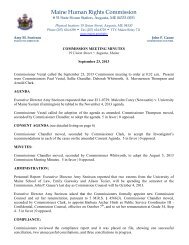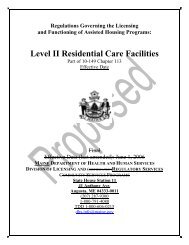SOS: A Handbook for Survivors of Suicide - American Association of ...
SOS: A Handbook for Survivors of Suicide - American Association of ...
SOS: A Handbook for Survivors of Suicide - American Association of ...
Create successful ePaper yourself
Turn your PDF publications into a flip-book with our unique Google optimized e-Paper software.
Battling Guilt (continued)<br />
Guilt is anger turned inward. <strong>Suicide</strong> produces many painful<br />
and confusing emotions in survivors, one <strong>of</strong> which is frustration<br />
at being so vio-<br />
lently cut <strong>of</strong>f from the<br />
victim—from the<br />
chance to help them,<br />
talk with them, or<br />
even simply to say<br />
goodbye. This frustration<br />
produces anger,<br />
and when we turn<br />
this anger upon ourselves,<br />
the result is<br />
guilt.<br />
Guilt can also<br />
come from an unfounded<br />
assumption<br />
that others are silently<br />
blaming us. Both parents<br />
and spouses<br />
express fear that the<br />
world at large will<br />
brand them as failures<br />
in their respective<br />
roles because <strong>of</strong> the<br />
suicide. While some<br />
small-minded people<br />
may think or even<br />
speak such accusations,<br />
most will not,<br />
so don’t project negative<br />
thoughts onto<br />
others by judging<br />
yourself <strong>for</strong> them.<br />
❦<br />
”If only I had...”<br />
A true tale <strong>of</strong> two mothers<br />
There were two young women who died by suicide,<br />
both about the same age, both after a years-long<br />
battle with depression. Each had made several suicide<br />
attempts. They would refuse pr<strong>of</strong>essional help<br />
and stop taking their medication just when it seemed<br />
to begin helping.<br />
Fearing <strong>for</strong> her life, the first woman’s mother had<br />
her committed—against her wishes—to a psychiatric<br />
clinic <strong>for</strong> treatment. While there, despite being<br />
on “suicide watch,” the young girl asphyxiated herself<br />
with her bedsheets.<br />
The second woman’s mother constantly urged her<br />
daughter to seek pr<strong>of</strong>essional help. However, fearing<br />
that she would worsen her daughter’s depression,<br />
she refused to <strong>for</strong>ce her into any kind <strong>of</strong> institutionalized<br />
care. One day, she killed herself with an overdose<br />
<strong>of</strong> medication.<br />
Afterwards, both mothers blamed themselves <strong>for</strong><br />
not preventing their daughter’s suicides. The irony is<br />
that each blamed themselves <strong>for</strong> not doing<br />
exactly what the other one did.<br />
The first mother felt that if she hadn’t isolated her<br />
daughter in that institution, she wouldn’t have lost<br />
her. The second was sure that if she only had committed<br />
her daughter, she would’ve been saved.<br />
We <strong>of</strong>ten fail to realize that, even if we could turn<br />
back the clock and do things differently, it wouldn’t<br />
necessarily change the outcome.<br />
18

















